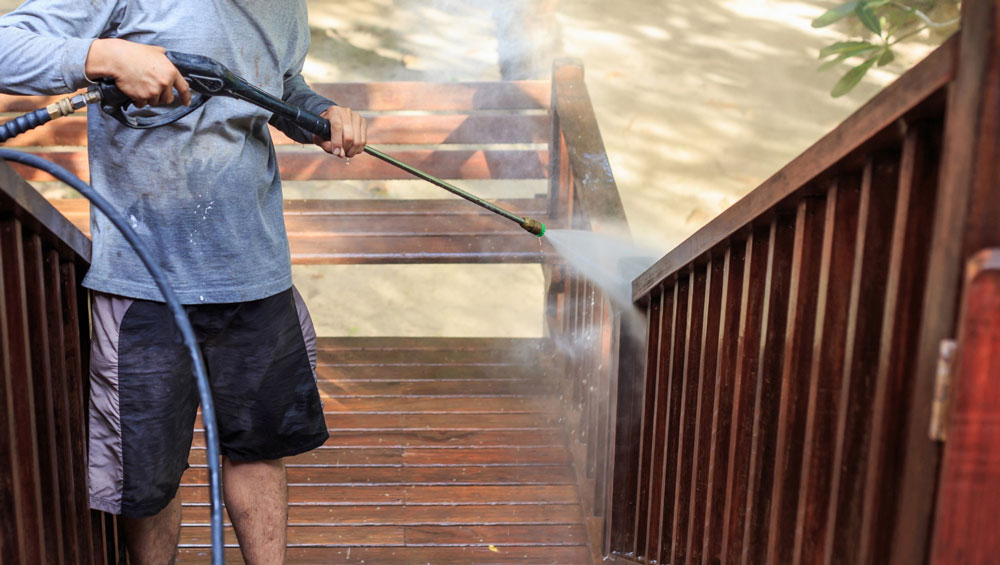
If you’re planning to clean the outside of your home — whether it’s the siding, deck, driveway, or roof — you’ll likely come across two popular terms: power washing and soft washing.
They both sound similar, and they both use water to clean. But don’t be fooled — they’re very different techniques, with different tools, pressures, and ideal use cases. Using the wrong one can damage your surfaces or leave grime behind.
In this article, we’ll break down the key differences between power washing and soft washing, when to use each one, and how to know which method is right for your specific project. 💦🏡
🧼 What Is Power Washing?
Power washing (also called pressure washing) uses high-pressure water, typically between 1,300 and 3,000 PSI, to blast away dirt, mold, algae, and debris from outdoor surfaces.
It’s most effective on:
- Concrete driveways and sidewalks
- Brick walls and patios
- Stone or paver surfaces
- Metal fencing
- Heavily soiled decks or siding (with care)
Power washing often relies on force alone to dislodge grime, with minimal or no chemicals required.
Browse Amazon Here For Top Rated Power Washers And Accessories
🧴 What Is Soft Washing?
Soft washing uses low-pressure water (under 500 PSI) combined with specialized cleaning solutions to gently remove dirt, mold, algae, mildew, and bacteria from surfaces.
It’s commonly used on:
- Roofs (especially asphalt shingles)
- Stucco, painted wood, and vinyl siding
- Cedar shake siding or fencing
- Screens and window exteriors
- Delicate surfaces or older materials
Soft washing kills organic growth at the root level — not just on the surface — and prevents it from returning quickly. Think of it as a disinfecting bath instead of a pressure blast.
Browse Amazon Here For Soft Washing Equipment And Accessories
💥 Key Differences Between Power Washing and Soft Washing
| Feature | Power Washing | Soft Washing |
|---|---|---|
| Water Pressure | High (1,300–3,000 PSI) | Low (< 500 PSI) |
| Cleaning Method | Force | Chemical |
| Ideal For | Hard surfaces (concrete, brick) | Delicate surfaces (roof, siding) |
| Risk of Damage | Higher | Low |
| Organic Growth Removal | Surface-level | Deep-root/root-level |
| Equipment | Pressure washer with standard nozzle | Soft wash system or pressure washer with special attachments |
Both methods are useful — but using them interchangeably can backfire.
🧠 When to Use Power Washing
Power washing is the best option when you’re dealing with:
- Tough grime or stains on solid surfaces
- Grease or oil on driveways or garage floors
- Moss or algae on concrete walkways
- Heavy buildup from construction, mud, or vehicles
Because it doesn’t rely heavily on chemicals, it’s great for:
- Eco-conscious users (if runoff is managed)
- Quick visual improvements
- Durable, flat surfaces
⚠️ Be careful using high pressure near mortar joints, soft wood, or any painted surface — it can cause damage quickly.
🌿 When to Use Soft Washing
Soft washing shines when you need to clean more fragile surfaces, or when you’re dealing with mold, mildew, or algae that keeps coming back.
Best uses include:
- Asphalt shingle roofs (high pressure can void warranties)
- Painted siding or wood surfaces
- Stucco or synthetic materials
- Deck railings, screens, and pergolas
- Areas shaded or prone to mildew (soft washing kills spores)
Soft washing also helps preserve protective coatings like sealants, stains, and paint — making it ideal before repainting or re-sealing a surface.
🧰 Equipment Used
Power Washing:
- Standard pressure washer (gas or electric)
- 0°, 15°, 25°, or 40° nozzle tips
- Optional: surface cleaner attachment
- Usually no soap required
Soft Washing:
- Specialized soft wash system (or modified pressure washer)
- Chemical injection or downstream injector
- Biodegradable detergent or algaecide
- Garden sprayer for application
Some professionals use dual systems that can switch between soft and power modes for maximum flexibility.
🛑 What Not to Power Wash
Never power wash:
- Asphalt shingle roofs
- Old wood siding
- Lead-painted surfaces
- Stucco (unless specifically rated for it)
- Window screens or seals
🧯 Use soft washing instead — or call a professional if you’re unsure.
🔄 Can You Combine the Two?
Absolutely! In fact, many professionals use both methods in one job depending on the surface. Here’s a smart example of a combo approach:
- Soft wash the siding and windows to remove mold and avoid damage
- Power wash the driveway and concrete for a deep clean
- Spot soft wash the deck railings, then light pressure wash the deck floor
This gives you the best of both worlds: deep cleaning power without unnecessary risk. ✅
💡 DIY or Hire a Pro?
Go DIY if:
- You’re experienced with pressure washers
- The surfaces are hard and straightforward
- You’re comfortable managing runoff and chemicals
Hire a Pro if:
- You need soft washing equipment or roof cleaning
- Your home has multiple stories or hard-to-reach spots
- You’re concerned about damaging siding or paint
- You want guaranteed results
Professionals often use commercial-grade solutions and equipment, plus they know how to handle different materials safely.
✅ Final Thoughts
Power washing and soft washing may seem similar, but they serve very different purposes. Choosing the right method depends on the surface, the type of buildup, and how deep you want to clean.
Here’s the quick recap:
- 💪 Power washing: Great for driveways, patios, brick, and hard surfaces
- 🌿 Soft washing: Best for roofs, siding, paint, and delicate areas
Using the right technique will not only make your home look better — it’ll help it last longer, too.
So next time you reach for that washer, ask yourself: “Should I use pressure — or go soft?” 🧼💡
Browse Amazon Here For Top Rated Power Washers And Accessories



